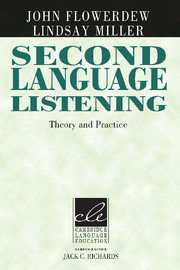Book contents
- Frontmatter
- Contents
- Series editor's preface
- Preface
- Acknowledgments
- Part I HISTORICAL BACKGROUND
- Part II A PEDAGOGICAL MODEL AND ITS APPLICATION
- Part III KEY ISSUES IN TEACHING AND TESTING
- 9 Developing Listening Skills through Technology
- 10 The Role of Questions in the Teaching of Listening
- 11 Testing Listening
- Appendix: Concluding Questions for Reflection
- References
- Index
9 - Developing Listening Skills through Technology
Published online by Cambridge University Press: 04 February 2010
- Frontmatter
- Contents
- Series editor's preface
- Preface
- Acknowledgments
- Part I HISTORICAL BACKGROUND
- Part II A PEDAGOGICAL MODEL AND ITS APPLICATION
- Part III KEY ISSUES IN TEACHING AND TESTING
- 9 Developing Listening Skills through Technology
- 10 The Role of Questions in the Teaching of Listening
- 11 Testing Listening
- Appendix: Concluding Questions for Reflection
- References
- Index
Summary
Introduction
With the ever-increasing accessibility of technology and the fast pace at which technology is changing today, the styles and strategies of students' learning are also developing and expanding. In this chapter, we look at how using technology can help develop listening skills. First, we look at lowtech components: radio, tape recorders, and language laboratories. Then we examine the huge influence video has had in language teaching. This area we categorize as mid-tech. Finally, we explore some of the high-tech features of computer technology in and out of the classroom.
Radio
Listening to the radio is one of the most accessible ways a learner has of developing listening skills. Radios are low-tech, and radio broadcasts are continuous. Listening to the radio, however, is not an activity that is often used in class time. Perhaps this is because radio listening can be done only in real time, and the scheduling of language classes to catch particular radio programs is difficult. Furthermore, the difficulties of obtaining copyright often prevent teachers from recording from the radio for classroom use. But it is still a listening medium that offers many potential benefits for learners, some of which are outlined below.
Extensive listening practice. Perhaps because of the real-time listening aspect of the radio, one of the most important dimensions it has to offer learners is the experience of listening to nonstop language. Learners are able to develop an “ear” for the language and tune in and out whenever they wish.
Access to native speaker models. In many L2 contexts the only oral models student have are of nonnative speakers speaking English.
- Type
- Chapter
- Information
- Second Language ListeningTheory and Practice, pp. 165 - 183Publisher: Cambridge University PressPrint publication year: 2005



